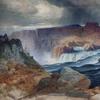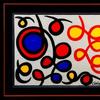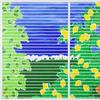AN UNTAMED ARTIST’S WORK ROARS BACK TO LIFE: Late Oklahoma painter O. Gail Poole gains new attention thanks to daughter’s efforts
- OKLAHOMA CITY, Oklahoma
- /
- January 22, 2015

As one of Oklahoma’s most prolific and adventurous artists, O. Gail Poole never stayed in one place long enough for anyone to build a box around him. The only constant was his unerring skill with a paintbrush, and when Poole died in 2013 at age 77, he left behind hundreds of oils, encaustics, pastels, watercolors and works in pen and ink, along with a Herculean task for his daughter, Nicole Poole.
Sequestering herself in a Norman, Okla. storage space over the course of two hot summers, Nicole Poole carefully catalogued her father’s work, which ranges wildly from traditional Western Art, Impressionism and Landscapes en plein air to Abstract Realism, Post-Impressionism and Playful Modernism.
Determined to bring her father’s work to the public, Nicole Poole poured her savings into producing the first posthumous exhibit of Poole’s work, aptly titled “As Yet Untamed,” which opened to rave reviews and strong coverage in December 2014.
“It’s a hard road to hoe,” she said, “Dad’s unpredictability left him misunderstood and unheralded during his life, but now folks are beginning to discover that his diversity was a deep strength that sets him apart from other artists.
“Dad was a maverick, and I’m a bull in a china shop,” she said. “Trying to retrofit him into the traditional hierarchy of the art world would go nowhere, so I’ve been unceremoniously knocking on back doors ever since he died, trying to create a custom way of thinking about Dad’s work. I was raised in Oklahoma, where we take pioneers very seriously, and I’m determined to buck the system.”
Critical acclaim is bolstering Nicole Poole’s resolve.
“I am astounded at the diversity of (Poole’s) art…he had a wondrous sense of style,” said Dr. Mary Jo Watson, Regents Professor of Art History at the University of Oklahoma.
Poole’s 50-year legacy began when he gave up his “Mad Men”-like buttoned-down prosperity as a founding partner of Poole-Hobbes Inc., one of the largest advertising agencies in Oklahoma at the time, and became his own kind of genial, provocative “mad man.”
“He was Don Draper, and he was a pro – he enjoyed the sound of deadlines whooshing past him,” said Nicole Poole. “But he got tired of ‘art by committee,’ and he threw it all away for a sense of freedom.”
After participating in the 1974 “Western Artists of Oklahoma” exhibit in Manz, Germany, Poole became a key player in the Southwestern art movement, and his early fine art beautifully captured America’s sunbaked West and its inhabitants. But Poole’s maverick nature would not allow him to rest, and the wide open spaces of his landscape art began to feel confining.
“He realized at one point that he was still just doing illustration,” Nicole Poole said. “It jarred him. He looked around and thought, ‘Everybody and his dog is doing this.’ He said, ‘I don't want to be known as a Western Artist ... Artist will do.’”
Under the tutelage of his mentor, Oklahoma-born impressionistic artist Richard Vernon Goetz, Poole dismantled and rebuilt his artistic approach, resulting in an astounding stretch of creativity. He delved into traditional landscapes, academic nudes, still life and portraiture during the 1980s, achieving widespread acclaim and creating high demand for his work among collectors. Goetz praised Poole as having surpassed him.
But Poole could never leave well enough alone. At the end of the 1980s, the artist hit the reset button once again, leaving many of his most ardent admirers utterly dumbfounded.
“He started doing these impressionistic figures in very fantastical scenes: seemingly disjoined and disembodied heads, or a cow wearing a Lone Ranger mask suspended on wires. He called that one ‘Cattle Thief,’” said Nicole Poole. “He experienced so much glee, because he was discovering his voice.”
Following his true north came with a price: Poole lost stature in the Oklahoma art market as his paintings became more aggressively idiosyncratic. But among his true fans, this was Poole’s golden age. Deeply hurt by audience rejection but defiant and determined, Poole resolved to paint for himself.
“That is the maverick, Okie spirit of O. Gail Poole that is so worthy of celebration,” Nicole Poole said.
Just hours prior to Poole’s death, on April 13, 2013, he was honored with a cedar and sage ceremony performed by a Comanche elder. At the ceremony, Nicole Poole made a solemn vow to her father.
“As we sang to him, I promised Dad I would take care of the paintings. And I am,” she said.
This labor of love involved moving hundreds of works out of Poole’s Norman home as OU students wrapped the art in acid-free paper and moved it into climate-controlled storage. With help from valuable Poole colleagues like curator Debby Williams, retired Sam Noble Museum of Natural History registrar Julie Droke, archivist Terri Jordan and photographer Mark Wilson, Nicole Poole’s efforts are bearing fruit. Thanks in part to former U.S. Senator and University of Oklahoma President David L. Boren, Ms. Poole secured an acquisition of Poole’s work “Morning Meeting” by OU’s Fred Jones Jr. Museum of Art. And in November 2014, Poole’s “First Immigrants/Mind of Man” was added to the Oklahoma State Art Collection.
Now, Nicole Poole is working toward the next steps, including a 2016 exhibit at Paris’ Galerie Arludik. But in the interim, she is actively seeking relationships with galleries, museums, publishers, educators and collectors intrigued by a rediscovered Oklahoma master.
“I just want him known,” she said. “The work is just too good – I want him to be embraced and finally recognized as one of the finest artists that Oklahoma has ever known. He may be gone, but I’ll be damned if he’ll be forgotten.”
For more information on O. Gail Poole, visit www.ogailpoole.com.











_(17100x100_c.jpg)




